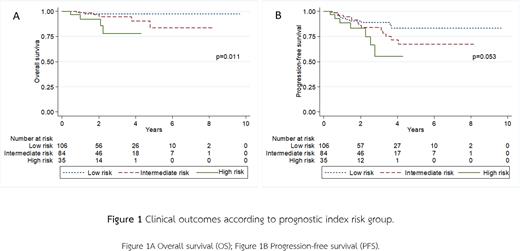Abstract
Introduction
Extranodal marginal zone lymphoma of mucosa-associated lymphoid tissue (MALT) is the most common subtype of marginal zone lymphoma (MZL) in Thailand. Results from the TLSG showed that almost half of the patients were ocular adnexal subtype (49.2%). However, there has been no validated prognostic index to predict outcome in these patients.
Objectives
This study aimed to describe epidemiology and develop prognostic index for ocular adnexa MALT lymphoma in Thai population.
Methods
Data from the TLSG were collected during January 2007 to March 2022. Patients who were diagnosed with ocular adnexa MALT lymphoma were enrolled. Demographic data including age, performance status (Eastern Cooperative Oncology Group; ECOG), stage of disease, lactate dehydrogenase (LDH), number of extranodal sites, presence of B symptoms and hepatitis profile were collected.
Univariate and multivariate analyses were performed by using Cox regression. Parameters found to be associated with progression-free survival (PFS) and overall survival (OS) in multivariate analysis were used to perform prognostic index. Kaplan-Meier survival curves were analyzed to predict PFS and OS stratified by this prognostic index.
Results
Two hundred twenty-five patients were enrolled to this study. Male was predominantly affected (60.4%). Median age at diagnosis was 59 years (range: 28-87). Most of the patients (216, 96%) had good performance status (ECOG 0-1). Thirty-three patients (14.3%) had more than 1 extranodal sites. Thirty-five patients (15.6%) had high LDH at first diagnosis of lymphoma.
Approximately half of the patients (116, 51.6%) were treated with chemotherapy. Twenty-three patients (10.2%) received immunotherapy (rituximab). Seventy-eight patients (34.7%) were radiated alone but only 3 patients (1.3%) in this registry underwent only surgery for treatment of ocular adnexa MALT lymphoma.
Three parameters (age >65 years, ECOG 2-4, and advanced stage) were found to be potentially affecting survival in multivariate analysis. The prognostic index was categorized into low, intermediate, and high risk, according to the number of these parameters (0, 1, ≥ 2, respectively).
Estimated 4-year OS for low-, intermediate- and high-risk groups were 97.4%, 90.9% and 77.9%, respectively, as shown in figure 1A (p-value=0.011). Estimated 4-year PFS for low-, intermediate- and high-risk groups were 82.5%, 69.2% and 55.4%, respectively (p-value=0.053), as shown in figure 1B.
Conclusions
This prognostic index can statistically discriminate among patients with ocular adnexa MALT lymphoma into low-, intermediate- and high-risk groups by OS. Although PFS can be stratified into 3 groups from this prognostic index, it has no statistical significance. Longer time of follow-up and more numbers of patients may result in statistical significance in near future.
Disclosures
No relevant conflicts of interest to declare.
Author notes
Asterisk with author names denotes non-ASH members.


